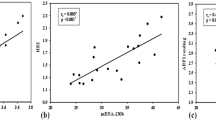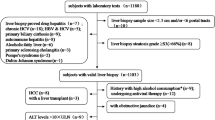Abstract
Background
Biliary atresia (BA), a chronic inflammatory disease of bile ducts, is characterized by the obliteration of bile flow. The aim of the present study was to investigate serum retinol binding protein 4 (RBP4) in postoperative BA patients and the association of RBP4 with clinical parameters and liver stiffness scores.
Methods
A number of forty-eight BA patients post Kasai operation and 24 controls were enrolled. None of the patients had undergone liver transplantation. BA patients were classified into two groups according to their serum total bilirubin (TB) levels (non-jaundice, TB < 2 mg/dl vs. jaundice, TB ≥ 2 mg/dl) and liver stiffness (insignificant fibrosis, liver stiffness <7 kPa vs. significant fibrosis, liver stiffness ≥7 kPa). Serum RBP4 levels were determined by enzyme-linked immunosorbent assay (ELISA). Liver stiffness scores were measured by FibroScan.
Results
BA patients had lower RBP4 levels (14.9 ± 1.0 vs. 18.7 ± 1.0 ng/ml, P = 0.02), but higher liver stiffness than controls (29.5 ± 3.3 vs. 5.0 ± 0.5 kPa, P < 0.001). Serum RBP4 levels were significantly decreased in BA patients with jaundice, compared with those without jaundice (9.5 ± 0.9 vs. 18.2 ± 1.2 ng/ml, P < 0.001). Moreover, BA patients with significant liver fibrosis displayed lower serum RBP4 than those with insignificant fibrosis (14.1 ± 1.2 vs. 21.2 ± 1.4 ng/ml, P = 0.02). Further analysis showed that serum RBP4 was strongly correlated with liver stiffness and serum albumin (r = −0.72, P < 0.001, and r = 0.65, P < 0.001, respectively). BA patients with portal hypertension (PH) had lower serum RBP4 than those without PH (12.8 ± 1.2 vs. 19.2 ± 1.7 ng/ml, P = 0.003).
Conclusion
Serum RBP4 levels decreased in BA patients compared with normal participants, and its levels declined significantly in patients with more severe disease. RBP4 may play a role in the pathogenesis of hepatic fibrosis and serve as a possible biomarker reflecting disease severity in postoperative BA patients.





Similar content being viewed by others
References
Mckirnan PJ, Baker AJ, Kelly DA. The frequency and outcome of biliary atresia in the UK and Ireland. Lancet 2000;355:25–29
Balistreri WF, Grand R, Hoofnagle JH, Suchy FJ, Ryckman FC, Perlmutter DH, et al. Biliary atresia: current concepts and research directions. Summary of symphosium. Hepatology 1996;23:1682–1692
Altman RP, Lilly JR, Greenfield J, Weinburg A, van Leeuwen K, Flanigan L. A multivariable risk factor analysis of the portoenterostomy (Kasai) procedure for biliary atresia: twenty-five years of experience from two centers. Ann Surg 1997;226:348–353
A-Kader HH, Abdel-Hameed A, Al-Shabrawi M, Mohsen N, El-Karaksy H, Hassanein B, et al. Is biliary atresia an autoimmune disease? Eur J Gastroenterol Hepatol 2003;5:447
Mark CL, Sokol RJ. Unraveling the pathogenesis and etiology of biliary atresia. Pediatr Res 2005;57:87R–94R
Gressner OA, Gressner AM. Connective tissue growth factor: a fibrogenic master switch in fibrotic liver diseases. Liver Int 2008;28:1065–1079
Gressner AM, Weiskirchen R. Modern pathogenetic concepts of liver fibrosis suggest stellate cells and TGF-beta as major players and therapeutic targets. J Cell Mol Med 2006;10:76–99
Chuang JH, Wang PW, Tai MH. An adipocentric view of liver fibrosis and cirrhosis. Chang Gung Med J 2004;27:855–868
Blaner WS. Retinol-binding protein: the serum transport protein for vitamin A. Endocr Rev 1989;10:308–316
Yang Q, Graham TE, Mody N, Preitner F, Peroni OD, Zabolotny JM, et al. Serum retinol binding protein 4 contributes to insulin resistance in obesity and type 2 diabetes. Nature 2005;436:356–362
Graham TE, Yang Q, Bluher M, Hammarstedt A, Ciaraldi TP, Henry RR, et al. Retinol-binding protein 4 and insulin resistance in lean, obese, and diabetic subjects. N Engl J Med 2006;354:2552–2563
Petta S, Camma C, Di Marco V, Alessi N, Barbaria F, Cabibi D, et al. Retinol-binding protein 4: a new marker of virus-induced steatosis in patients infected with hepatitis C virus genotype 1. Hepatology 2008;48:28–37
Seo JA, Kim NH, Park SY, Kim HY, Ryu OH, Lee KW, et al. Serum retinol-binding protein 4 levels are elevated in non-alcoholic fatty liver disease. Clin Endocrinol 2008;68:555–560
Bahr MJ, Boeker KHW, Manns MP, Tietge UJF. Decreased hepatic RBP4 secretion is correlated with reduced hepatic glucose production but is not associated with insulin resistance in patients with liver cirrhosis. Clin Endocrinol 2009;70:60–65
Yagmur E, Weiskirchen R, Gressner AM, Trautwein C, Tacke F. Insulin resistance in liver cirrhosis is not associated with the circulating retinol-binding protein 4. Diabetes Care 2007;30:1168–1172
Schina M, Koskinas J, Tiniakos D, Hadziyannis E, Savvas S, Karamanos B, et al. Circulating and liver tissue levels of retinol-binding protein 4 in non-alcoholic fatty liver disease. Hepatol Res 2009;39:972–978
Nobili V, Alkhouri N, Alisi A, Ottino S, Lopez R, Manco M, et al. Retinol-binding protein 4: promising circulating marker of liver damage in pediatric nonalcoholic fatty liver disease. Clin Gastroenterol Hepatol 2009;7:575–579
Alkhouri N, Lopez R, Berk M, Feldstein AE. Serum retinol-binding protein 4 levels in patients with nonalcoholic fatty liver disease. J Clin Gastroenterol 2009;43:985–989
Tacke F, Weiskirchen R, Trautwein C. Liver function critically determines serum retinol-binding protein 4 (RBP4) levels in patients with chronic liver disease and cirrhosis. Hepatology 2008;48:1724–1725
Huang JF, Dai CY, Yu ML, Shin SJ, Hsieh MY, Huang CF, et al. Serum retinol-binding protein 4 is inversely correlated with disease severity of chronic hepatitis C. J Hepatol 2009;50:471–478
Honsawek S, Chayanupatkul M, Chongsrisawat V, Vejchapipat P, Poovorawan Y. Increased osteopontin and liver stiffness measurement by transient elastography in biliary atresia. World J Gastroenterol 2010;16:5467–547
Honsawek S, Chaiwatanarat T, Chongsrisawat V, Thawornsuk N, Vejchapipat P, Poovorawan Y. Circulating leptin levels and bone mineral density in children with biliary atresia. Acta Paediatr 2008;97:206–211
Honsawek S, Chongsrisawat V, Vejchapipat P, Thawornsuk N, Poovorawan Y. High levels of serum basic fibroblast growth factor in children with biliary atresia. Hepatogastroenterology 2008;55:1184–1188
Wai CT, Greenson JK, Fontana RJ, Kalbfleisch JD, Marrero JA, Conjeevaram HS, et al. A simple noninvasive index can predict both significant fibrosis and cirrhosis in patients with chronic hepatitis C. Hepatology 2003;38:518–526
Chang HK, Park YJ, Koh H, Kim SM, Chung KS, Oh JT, et al. Hepatic fibrosis scan for liver stiffness score measurement: a useful preendoscopic screening test for the detection of varices in postoperative patients with biliary atresia. J Pediatr Gastroenterol Nutr 2009;49:323–328
Castara L, Vergniol J, Foucher J, Le Bail B, Chanteloup E, Haaser M, et al. Prospective comparison of transient elastography, Fibrotest, APRI, and liver fibrosis for the assessment of fibrosis in chronic hepatitis C. Gastroenterology 2005;128:343–350
Bluher M, Tonjes A, Stumvoll M. Dose retinol-binding protein 4 cause or reflect fatty liver disease? Hepatology 2008;48:4–6
Ohata M, Lin M, Satre M, Tsukamoto H. Diminished retinoic acid signaling in hepatic stellate cells in cholestatic liver fibrosis. Am J Physiol 1997;272:G589–G596
Wang L, Attard FA, Tankersley LR, Potter JJ, Mezey E. Effect of retinoic acid on the enhancing effect of acetaldehyde on mouse type I collagen expression. Arch Biochem Biophys 2000;376:191–198
Frey SK, Nagl B, Henze A, Raila J, Schlosser B, Berg T, et al. Isoforms of retinol binding protein 4 (RBP4) are increased in chronic diseases of the kidney but not of the liver. Lipids Health Dis 2008;7:29
Quadro L, Blaner WS, Salchow DJ, Vogel S, Piantedosi R, Gouras P, et al. Impaired retinol function and vitamin A availability in mice lacking retinol-binding protein. EMBO J 1999;18:4444–4633
Foucher J, Chanteloup E, Vergniol J. Diagnosis of cirrhosis by transient elastography (FibroScan): a prospective study. Gut 2006;55:403–408
Cengiz C, Ardicoglu Y, Bulut S, Boyacioglu S. Serum retinol-binding protein 4 in patients with nonalcoholic fatty liver disease: dose it have a significant impact on pathogenesis. Eur J Gastroenterol Hepatol 2010;22:813–819
Acknowledgements
This research has been facilitated by the Ratchadapiseksompotch Fund, Faculty of Medicine, Chulalongkorn University, Thailand Research Fund, and the Commission on Higher Education. The authors are profoundly grateful to the entire staff of the Centre of Excellence in Clinical Virology, Chulalongkorn University and King Chulalongkorn Memorial Hospital for their combined effort in this study. We would also like to thank Ms. Petra Hirsch for reviewing the manuscript. This study was also supported in part by the National Research University Project of CHE and the Ratchadaphiseksomphot Endowment Fund (HR1155A).
Author information
Authors and Affiliations
Corresponding author
Rights and permissions
About this article
Cite this article
Chayanupatkul, M., Honsawek, S., Chongsrisawat, V. et al. Serum retinol binding protein 4 and clinical outcome in postoperative biliary atresia. Hepatol Int 5, 906–912 (2011). https://doi.org/10.1007/s12072-011-9262-2
Received:
Accepted:
Published:
Issue Date:
DOI: https://doi.org/10.1007/s12072-011-9262-2




